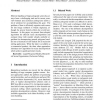Free Online Productivity Tools
i2Speak
i2Symbol
i2OCR
iTex2Img
iWeb2Print
iWeb2Shot
i2Type
iPdf2Split
iPdf2Merge
i2Bopomofo
i2Arabic
i2Style
i2Image
i2PDF
iLatex2Rtf
Sci2ools
VMV
2001
2001
Generation of Decomposition Hierarchies for Efficient Occlusion Culling of Large Polygonal Models
Efficient handling of large polygonal scenes has always been a challenging task and in recent years, view-frustum and occlusion culling have drawn a lot of attention for accomplishing this goal. The problem of how to efficiently organize such scenes for fast image synthesis is widely neglected, although the answer heavily affects the overall performance. In this paper, we present three adapted algorithms for efficient scene decomposition and compare those with another already available algorithm for decomposing general polygonal models into a hierarchy of sub-models for an occlusion culling application. While the latter is available as a commercial product, the three other approaches introduce new algorithms for scene decomposition which achieve significant better results.
| Added | 31 Oct 2010 |
| Updated | 31 Oct 2010 |
| Type | Conference |
| Year | 2001 |
| Where | VMV |
| Authors | Michael Meißner, Dirk Bartz, Gordon Müller, Tobias Hüttner, Jens Einighammer |
Comments (0)

